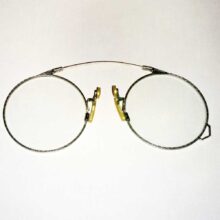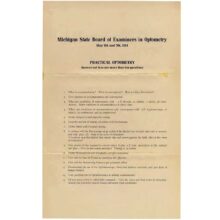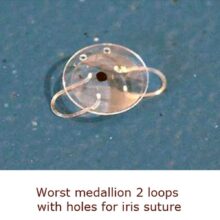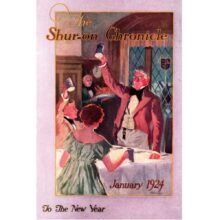Liebreich ophthalmoscope 1870
Liebreich was born in East Prussia, Europe in 1830. He studied there and in Berlin and received his doctorate in 1853. He was a preparator for Helmholtz, the inventor of the ophthalmoscope, in 1851.
While assisting in Graefe’s clinic from 1854 to 1862, Liebreich published a classic treatise about ophthalmoscopy in the French edition of Mackenzie’s book.
In 1862 Liebreich settled in Paris and published his famous atlas of ophthalmoscopy.
In 1870 he moved to London and directed the ophthalmic section at St. Thomas’ Hospital from 1871 to 1878. Later he moved to Paris, where he died in 1917.
Liebreich first described his stand ophthalmoscope in 1855. There were two short brass tubes. They were adjusted by a screw thread. The tube near the observer had a section with a metal concave mirror held by two double springs. This mirror was rotatable around the vertical axis and could be removed.
The other tube held a convex lens on the side near the patient. It also rotated around the vertical axis and could be removed. A small button at the end of a linked rod served as a fixation target. The image in the tub could be projected on the table top with a camera lucida. There was a cushioned forehead and chin rest as well as a light shade.
This was made by Patz and Flohr, opticians in Berlin.
Liebreich soon ran Graefe’s clinic. Anagnostakis from Greece was training with Graefe from 1851 to 1854. While there he came up with the idea of making the instrument hand held with a concave mirror. Liebreich embraced this and sketched the model he preferred in his treatise about ophthalmoscopy in 1857.
In 1861 Hulke described both the small and large instruments of Liebreich. So the hand held version began around 1860 and lasted for almost 50 years. In the beginning of the 1870’s the metal mirror was replaced by glass which was free of coating in the center. So, if a Liebreich ophthalmoscope has a glass mirror, then it dates from the 1870’s or later.
This is a unsigned version of the Liebreich opthalmoscope.
The case is a little over 5 1/4 inches wide and has LIEBREICH’S OPHTHALMOSCOPE written in gold on the lid. There is a part of a stamp on the underside of the case with the number 4200 and D.F on it.
It comes with two of the original five viewing lenses and no condensing lenses of the original two, for indirect ophthalmoscopy.










